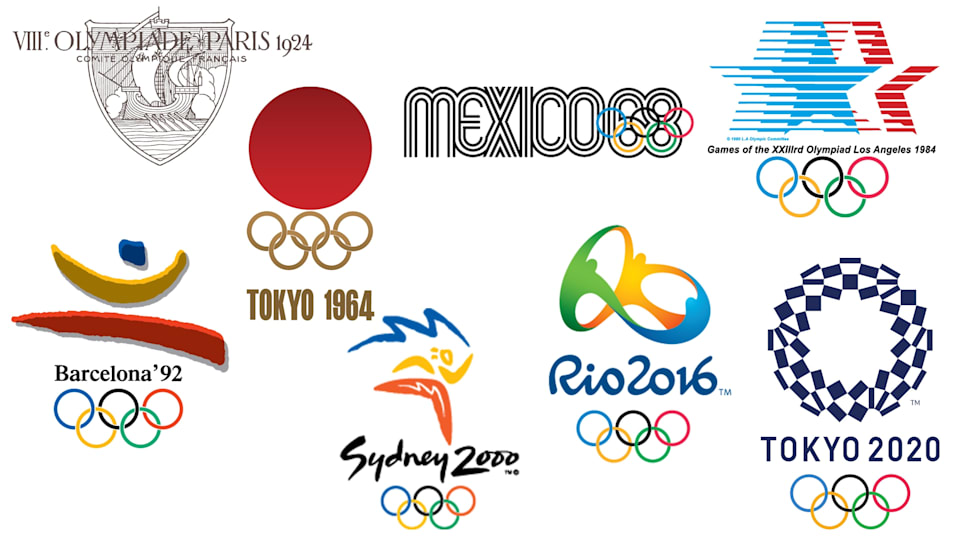A look back at the emblems of the Olympic Games
To mark the unveiling of the Paris 2024 Games emblem, olympic.org takes a look back at some of the most well-known emblems from Olympic Games editions in the modern era, stretching back over a century.

There was no emblem for the Paris 1900 Games per se – in fact there was not even an Olympic symbol (the flag with the five interlacing rings would not be created by Pierre de Coubertin until 1913) – but rather a number of famous posters, including one depicting a woman holding the three weapons of fencing, together with the words “international fencing competitions”, which were held as part of the 1900 World’s Fair in the French capital.
In 1924, on the other hand, the Games did have an emblem. It featured the words “VIII Olympiad Paris 1924” and, underneath, “French Olympic Committee” (in French), and depicted the coat of arms of the city of Paris, but without the motto “fluctuat nec murgitur” (“it is tossed by the waves but does not sink”). The image was that of a sailing ship, complete with oars, travelling up the Seine. The blazon, or formal description of the coat of arms, reads: “Gules, on waves of the sea in base a ship in full sail Argent, a chief Azure semé-de-lis Or”. This was the second time that the French capital had hosted the Games, and the symbol was chosen for its historical significance – a coat of arms that dates back to the 14th century.
The emblem for the Tokyo 1964 Games was created by renowned Japanese graphic designer Yusaku Kamekura. Legend has it that he came up with the emblem in just a few hours. It used the red circle of the Japanese flag, representing the sun, or more specifically the Shinto religion sun deity Amaterasu. Underneath the red circle were the Olympic rings and the words “Tokyo 1964” in gold letters.
Rooted in pop art innovation, the Mexico City 1968 emblem also took inspiration from pre-Columbian Mexican art. The starting point of the design was the five Olympic rings, which were incorporated into the figure 68. The emblem clearly identified the country, year and sporting event, and was grounded in both Mexican culture and modernity.
Sixteen years later, slightly further north, Los Angeles, California, played host to the Olympic Games for the second time. The emblem of the Games of the XXIII Olympiad Los Angeles 1984 featured the stars of the American flag in the national colours of red, white and blue. The stars were cut through with horizontal streaks, evoking movement, speed and dynamism, with the straight lines conjuring images of 100m sprinters running at full speed.
Back in Europe, the famous three-stroke emblem of the Barcelona 1992 Games depicted an athlete running or jumping. The yellow and red lines were the colours of Spain, while the blue that formed the figure’s head was a nod to Barcelona’s proximity to the Mediterranean Sea. The “Barcelona ‘92” typography was in bold Times New Roman – Roman-ness, Latin-ness and seriousness.
A similar idea lay behind the emblem of the Sydney 2000 Games: a brush-drawn athlete in motion with legs formed by a boomerang. The white flash above the figure evoked the peaks of the iconic Sydney Opera House. The colours of blue, yellow and red were references to the sun, rocks, sea and unique landscapes of Australia, and its indigenous people.
At first sight, the emblem of the Rio 2016 Games, with its shades of blue, green and orange-yellow (the colours of the Brazilian flag), represented three figures joining hands to form a circle. But on closer inspection, one can make out the three letters R, I and O. The emblem design was inspired by the city’s famous Sugarloaf Mountain backdrop. According to the design agency that created it, the emblem depicted Sugarloaf Mountain and the city of Rio in movement, with three people embracing the city and the ideal of the Olympic spirit. It evoked themes of sporting prowess and challenges, as well as control and exuberant energy, while its overall shape also resembled that of a heart. In short, every time you look at it, you see something different.
Finally, let’s head back to Tokyo for the Games that will be taking place next year, with the emblem created by Japanese designer Asao Tokoro: a “harmonised chequered” circle. Chequered patterns and motifs have been popular throughout history all over the world. In Japan, the chequered pattern became formally known as “ichimatsu moyō” during the Edo period (1603-1867). The emblem design, in the traditional Japanese colour of indigo, expresses the refined elegance and sophistication that exemplifies Japan. Composed of three varieties of rectangular shapes, the design incorporates a message of “Unity in Diversity” and expresses a desire for the Olympic and Paralympic Games to become a platform to promote diversity and bring people from all over the world together.